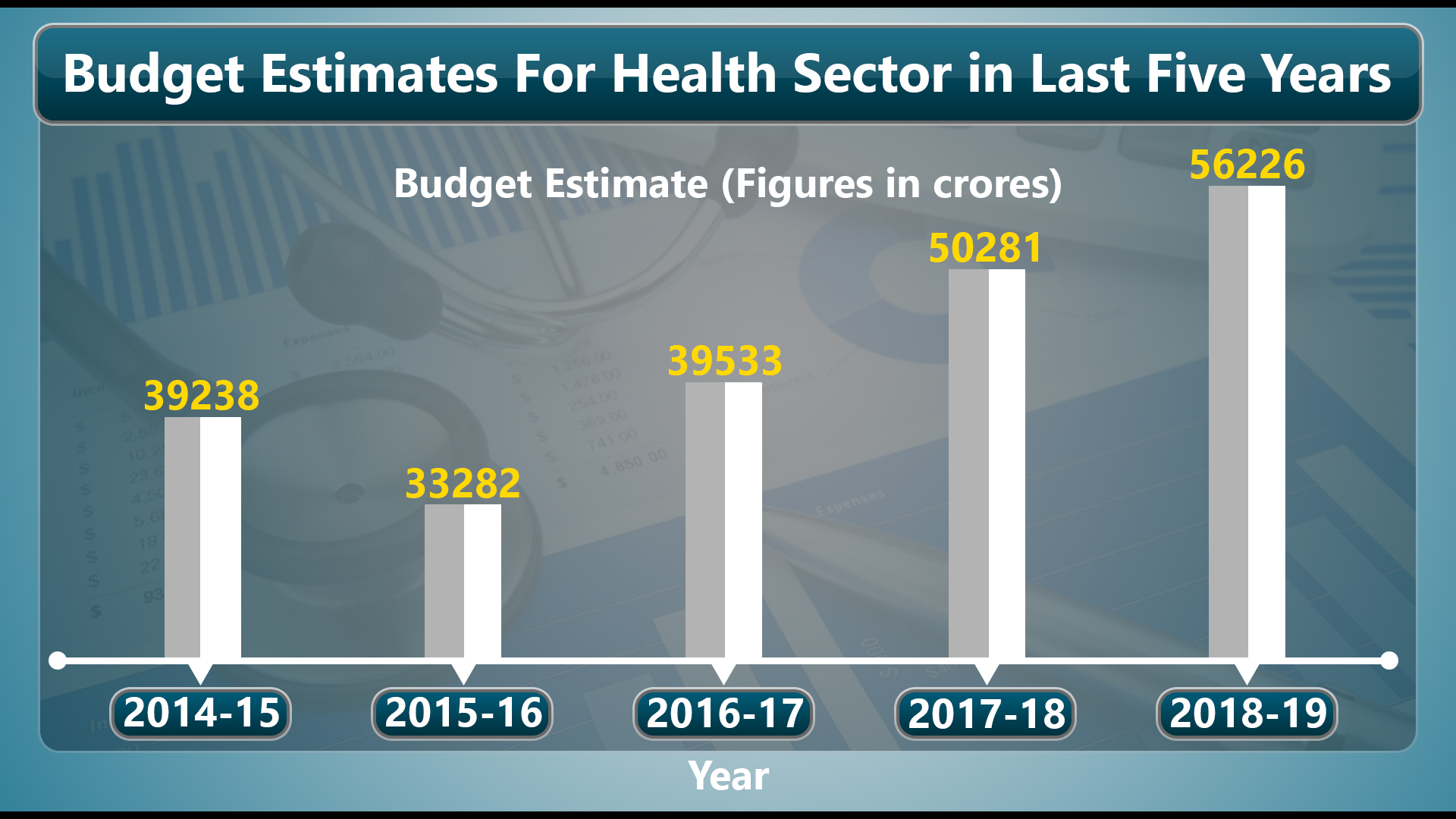ಮುಂಬಯಿ: ಎನ್.ಡಿ.ಎ. ಸರಕಾರವು ತನ್ನ ಎರಡನೇ ಅವಧಿಯಲ್ಲಿ ಮೊದಲನೇ ಬಜೆಟ್ ಮಂಡಿಸುತ್ತಿದ್ದು, ದೇಶದ ಅಭಿವೃದ್ಧಿಯಲ್ಲಿ ಮುಖ್ಯ ಪಾತ್ರವಹಿಸುತ್ತಿರುವ ಆರೋಗ್ಯ ಕ್ಷೇತ್ರದಲ್ಲಿ ಬಜೆಟ್ ಹಂಚಿಕೆಯ ಕುರಿತು ಉತ್ಸಾಹ ಕಂಡುಬರುತ್ತಿದೆ.
ಶ್ರೀಲಂಕಾ (1.6%) ಹಾಗೂ ಭೂತಾನ್ಗೆ (2.5%) ಹೋಲಿಸಿದರೆ, ಭಾರತವು ಕಡಿಮೆ ವೆಚ್ಚವನ್ನುಆರೋಗ್ಯ ಕ್ಷೇತ್ರಕ್ಕೆ ವ್ಯಯಿಸುತ್ತಿದೆ. ಭಾರತವು ಸರಿಸುಮಾರು ಶೇಕಡಾ 1.4ರಷ್ಟು ಜಿ.ಡಿ.ಪಿ.ಯನ್ನು ಈ ಕ್ಷೇತ್ರಕ್ಕೆ ಮೀಸಲಿಡುತ್ತಿದೆ.
ಈ ಹಿಂದೆ ಎನ್.ಡಿ.ಎ. ಸರಕಾರವು ತನ್ನ ಮೊದಲನೇ ಆಡಳಿತಾವಧಿಯಲ್ಲಿ ಮಂಡಿಸಿದ 2019-20ನೇ ಸಾಲಿನ ಮಧ್ಯಂತರ ಬಜೆಟ್ನಲ್ಲಿ ಆರೋಗ್ಯ ಕ್ಷೇತ್ರಕ್ಕೆ ಹೆಚ್ಚಿನ ಹಂಚಿಕೆ ಮಾಡಿರುವುದು ಉತ್ತಮ ಬೆಳವಣಿಗೆಯಾಗಿದೆ.
61,398 ಕೋಟಿ ರೂಪಾಯಿಗಳನ್ನು ಮಧ್ಯಂತರ ಬಜೆಟ್ನಲ್ಲಿ ಆರೋಗ್ಯ ಕ್ಷೇತ್ರಕ್ಕೆ ಮೀಸಲಿರಿಸಿದ್ದು, ಈ ಹಿಂದಿನ ಹಂಚಿಕೆಗಿಂತ ಶೇಕಡಾ16.3ರಷ್ಟು ಅಧಿಕವಾಗಿದೆ.

ಬಜೆಟ್ ಹಂಚಿಕೆಯು ಸಮತೋಲಿತ ವಿಧಾನದಲ್ಲಿರಬೇಕು. ಉದಾಹರಣೆಗೆ, ಮಧ್ಯಂತರ ಬಜೆಟ್ನಲ್ಲಿ ಆಯುಷ್ಮಾನ್ ಭಾರತ್ ಯೋಜನೆಗೆ ಹೆಚ್ಚು ಬಜೆಟ್ ಹಂಚಿಕೆಯಾಗಿದ್ದು, ಕಳೆದ ಹಣಕಾಸು ವರ್ಷಕ್ಕೆ ಹೋಲಿಸಿದರೆ ಇದು ಶೇಕಡಾ 166ರಷ್ಟು ಅಧಿಕವಾಗಿತ್ತು.
ಇದೇ ಸಂದರ್ಭದಲ್ಲಿ ಸಾಂಕ್ರಾಮಿಕವಲ್ಲದ ರೋಗಗಳು, ಗಾಯ ಮತ್ತು ಆಘಾತ, ರಾಷ್ಟ್ರೀಯ ಕ್ಯಾನ್ಸರ್ ನಿಯಂತ್ರಣ ಹಾಗೂ ತಡೆಗಟ್ಟುವಿಕೆಯ ಕಾರ್ಯಕ್ರಮ ಡಯಾಬಿಟಿಸ್, ಹೃದಯಸಂಬಂಧಿ ಕಾಯಿಲೆಗಳು ಹಾಗೂ ಸ್ಟ್ರೋಕ್ಗೆ ಸಂಬಂಧಿಸದ ಬಜೆಟ್ ಹಂಚಿಕೆಯಲ್ಲಿ ಕಡಿತ ಉಂಟಾಯಿತು. ಈ ಕ್ಷೇತ್ರಗಳಿಗೆ ಹೆಚ್ಚಿನ ಗಮನ ಹಾಗೂ ಬಜೆಟ್ ಹಂಚಿಕೆಯ ಅಗತ್ಯವಿದೆ.
ದೇಶದ ಶೇಕಡಾ 40ರಷ್ಟು ಜನತೆಗೆ, ಕುಟುಂಬವೊಂದಕ್ಕೆ 5 ಲಕ್ಷದಷ್ಟು ಆರೋಗ್ಯ ವಿಮೆಯ ಸೌಲಭ್ಯ ನೀಡುವ ಉದ್ದೇಶವನ್ನು ಆಯುಷ್ಮಾನ್ ಭಾರತ್ ಯೋಜನೆ ಹೊಂದಿದ್ದರೂ, ಆರೋಗ್ಯ ಕ್ಷೇತ್ರದ ಇತರ ಭಾಗಗಳಿಗೂ ಗಮನಹರಿಸುವುದು ಅಷ್ಟೇ ಮುಖ್ಯವಾಗಿದೆ.
ಆರೋಗ್ಯ ಮೂಲಸೌಕರ್ಯದ ಕೊರತೆ:
ಆರೋಗ್ಯ ಕ್ಷೇತ್ರದಲ್ಲಿ ಮೂಲಸೌಕರ್ಯಗಳ ಕೊರತೆಯು ಗಂಭೀರ ಸಮಸ್ಯೆಯಾಗಿದ್ದು, ಅವುಗಳೆಡೆಗೆ ಗಮನಹರಿಸುವ ಅಗತ್ಯವಿದೆ. 2016ರ ಗ್ರಾಮೀಣ ಆರೋಗ್ಯ ಅಂಕಿ ಅಂಶಗಳ ಪ್ರಕಾರ ದೇಶಾದ್ಯಂತ ಶೇಕಡಾ 22ರಷ್ಟು ಪ್ರಾಥಮಿಕ ಆರೋಗ್ಯ ಕೇಂದ್ರ, ಶೇಕಡಾ 20ರಷ್ಟು ಉಪ ಆರೋಗ್ಯ ಕೇಂದ್ರ ಹಾಗೂ ಶೇಕಡಾ 30ರಷ್ಟು ಸಮುದಾಯ ಆರೋಗ್ಯ ಕೇಂದ್ರಗಳ ಕೊರತೆಯಿದೆ.
ಮುಖ್ಯವಾಗಿ, ದೇಶದ ಜನಸಂಖ್ಯೆ ಹಾಗೂ ಸರಕಾರಿ ಆಸ್ಪತ್ರೆಗಳ ವೈದ್ಯರ ಅನುಪಾತವು ವಿಶ್ವ ಆರೋಗ್ಯ ಸಂಸ್ಥೆ ಶಿಫಾರಸು ಮಾಡಿರುವ ಅನುಪಾತಕ್ಕಿಂತ 25 ಪಟ್ಟು ಕಡಿಮೆಯಿದೆ.
ಅಧಿಕ ಬಜೆಟ್ ಹಂಚಿಕೆಯ ಅವಶ್ಯಕತೆ:
ಆರೋಗ್ಯ ಕ್ಷೇತ್ರಕ್ಕೆ ಅಧಿಕ ಬಜೆಟ್ ಹಂಚಿಕೆ ಹಾಗೂ ಸ್ಥಿರವಾದ ಮೇಲ್ವಿಚಾರಣೆಯ ಅಗತ್ಯತೆಯಿದೆ. ತಾಯಿಯ ಮರಣ ಪ್ರಮಾಣ ಹಾಗೂ ಶಿಶು ಮರಣ ಪ್ರಮಾಣಕ್ಕೆ ಸಂಬಂಧಿಸಿದಂತೆ, ಬಡ ದೇಶಗಳಾದ ರುವಾಂಡಾ ಹಾಗೂ ಇಥಿಯೋಪಿಯಾ ಕಡಿಮೆ ಖರ್ಚಿನೊಂದಿಗೆ ಉತ್ತಮ ಪಾಠ ನೀಡುತ್ತಿದೆ.
ಆರೋಗ್ಯ ಕಾರ್ಯಕರ್ತರ ಹೊಣೆಗಾರಿಕೆ ಹಾಗೂ ಪ್ರೋತ್ಸಾಹಕಗಳ ಲಿಂಕ್:
ಆರೋಗ್ಯ ಕಾರ್ಯಕರ್ತರ ಹೊಣೆಗಾರಿಕೆ ಹಾಗೂ ಪ್ರೋತ್ಸಾಹಕಗಳನ್ನು ಲಿಂಕ್ ಮಾಡಲು ರುವಾಂಡಾ ಪ್ರಯತ್ನಿಸಿದೆ. ಕ್ಲಿನಿಕಲ್ ಮಾರ್ಗಸೂಚಿಗಳನ್ನು ಅನುಸರಿಸಲು ಧನ ರೂಪದಲ್ಲಿ ಪ್ರೋತ್ಸಾಹಗಳನ್ನು ನೀಡಲಾಯಿತು. ಇದರ ಪರಿಣಾಮವಾಗಿ ಅವರ ಕಾರ್ಯಕ್ಷಮತೆಯಲ್ಲಿ ಗಮನಾರ್ಹ ಸುಧಾರಣೆ ಕಂಡು ಬಂತು. ಜೊತೆಗೆ ರುವಾಂಡಾದ ಸರಕಾರವು ಸ್ಥಳೀಯ ಆರೋಗ್ಯ ಸೇವೆಗಳ ಗುಣಮಟ್ಟದ ಕುರಿತು ಸಾರ್ವಜನಿಕರಿಗೆ ಮಾಹಿತಿ ನೀಡುವ ಮೂಲಕ ಅವರಲ್ಲಿ ಜಾಗೃತಿ ಮೂಡಿಸಿತು.
ಆರೋಗ್ಯ ವಿಸ್ತರಣಾ ಕಾರ್ಯಕರ್ತರಿಗೆ ತರಬೇತಿ:
ಇಥಿಯೋಪಿಯಾ ದೇಶವು ಸಹ ತನ್ನ ಆರೋಗ್ಯ ಸ್ಥಿತಿಯನ್ನು ಸುಧಾರಿಸುವಲ್ಲಿ ಉದಾಹರಣೆಯಾಗಿ ನಿಂತಿದೆ. ಈ ದೇಶವು ಒಂದು ವರ್ಷದಲ್ಲಿ ಸಾವಿರಾರು ಆರೋಗ್ಯ ವಿಸ್ತರಣಾ ಕಾರ್ಯಕರ್ತರಿಗೆ ಹಾಗೂ ಗ್ರಾಮೀಣ ಪ್ರೌಢಶಾಲಾ ಪದವೀಧರರಿಗೆ ತರಬೇತಿ ನೀಡಿತು, ಬಳಿಕ ಅವರನ್ನು ಅವರ ಸ್ಥಳೀಯ ಪ್ರದೇಶಗಳಿಗೆ ಕಳುಹಿಸಲಾಯಿತು. ಇದರ ಪರಿಣಾಮವಾಗಿ ಶಿಶು ಮರಣ ಪ್ರಮಾಣವು ಶೇಕಡಾ 32 ಹಾಗೂ ತಾಯಿಯ ಮರಣ ಪ್ರಮಾಣವು ಶೇಕಡಾ 38ರಷ್ಟು ಕಡಿಮೆಯಾಯಿತು.
ಇಂತಹ ಬಡ ದೇಶಗಳ ಕ್ರಮಗಳನ್ನು ಭಾರತದ ಬಜೆಟ್ ಹಂಚಿಕೆಯಲ್ಲಿ ಅಳವಡಿಸಿದರೆ, ಆರೋಗ್ಯ ಕ್ಷೇತ್ರದ ಕಾರ್ಯಕ್ಷಮತೆಯಲ್ಲಿ ಸುಧಾರಣೆ ಕಾಣಬಹುದು.
( ಡಾ. ಮಹೇಂದ್ರ ಬಾಬು ಕುರುವ, ಸಹಾಯಕ ಪ್ರಾಧ್ಯಾಪಕರು, ಎಚ್.ಎನ್.ಬಿ. ಗರ್ವಾಲ್ ಕೇಂದ್ರ ವಿಶ್ವವಿದ್ಯಾನಿಲಯ, ಉತ್ತರಾಖಂಡ್)



